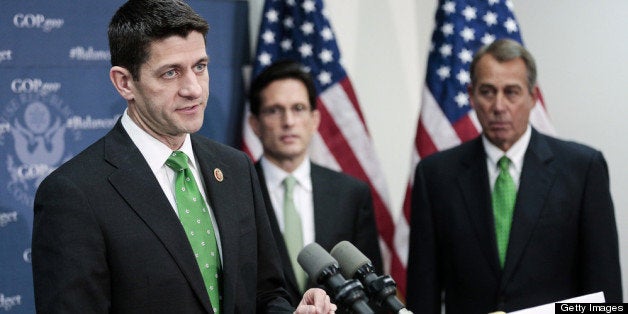
Though you may have heard otherwise, austerity is in full force in the U.S., helping the government pay down debt for the first time in six years.
The Treasury Department on Monday said it expects to cut its "marketable" debt load by $35 billion in the current quarter, the first such reduction since the second quarter of 2007, when it shed $139 billion in debt. What did the trick? Higher tax receipts and lower government spending -- an austerity cocktail.
Together with the Federal Reserve's program to buy up $45 billion per month in Treasury debt, this adds to the idea that there is a shortage of available "safe" debt in the market, which is helping to keep interest rates near record lows despite the many warnings of the debt and deficit scolds that too much government debt will send rates soaring. On Monday, the yield on the 10-year Treasury note dipped to 1.65 percent, the lowest since last December, according to data tracker Tradeweb. That's not far from the record low of less than 1.4 percent set last July.
This is also Exhibit A of the debt-and-deficit panic that has gripped Washington for the past couple of years. With economic growth sluggish and unemployment hanging around 8 percent, textbook economics suggests the government should go deeper into debt to help stimulate the economy. Instead, U.S. policymakers, partly inspired by the now-debunked warnings of Carmen Reinhart and Kenneth Rogoff that too much government debt saps growth, have worked much harder on slashing spending.
As a result, the U.S. government has embarked on its biggest austerity campaign since the end of the Vietnam War and its second-biggest spending squeeze since the end of World War II, the London research firm Capital Economics pointed out in a research note on Monday. Inflation-adjusted government spending has been cut by 7 percent in the past two years, according to Capital Economics, roughly matching post-Vietnam cuts and second only to the 11 percent decline after the Korean War.
And the government has only just begun to cut spending: Capital Economics estimates that the squeeze from the draconian budget cuts known as sequestration will sap 0.7 percentage points from economic growth in the next 12 months. Cutbacks in government spending subtracted 0.8 percentage points from gross domestic product growth in the first quarter alone, the Bureau of Economic Analysis reported on Friday.
"[O]ver the next 12 months the public sector will remain a significant drag on economic growth," wrote Paul Ashworth, chief U.S. economist at Capital Economics.
Combining state, local and federal spending cuts -- as Paul Krugman suggests we do -- the total budget deficit in the U.S. will likely fall to 3.9 percent of gross domestic product by next year, according to International Monetary Fund estimates. That's down from 8.5 percent in 2010, notes Capital Economics. This decline of 4.6 percent is bigger than the 3.5 percent drop in Europe's budget deficit over the same period.
"Despite all the talk of austerity in Europe, America is doing just as much to rein in budget deficits," wrote Ashworth.
And Americans are paying a similar price, in slower growth and higher unemployment. And health problems. And possibly suicides.
This would be the moment to point out, again, that the Reinhart-Rogoff research that formed the intellectual underpinning of this austerity movement has been discredited -- and that the austerians are sticking to their guns anyway.
